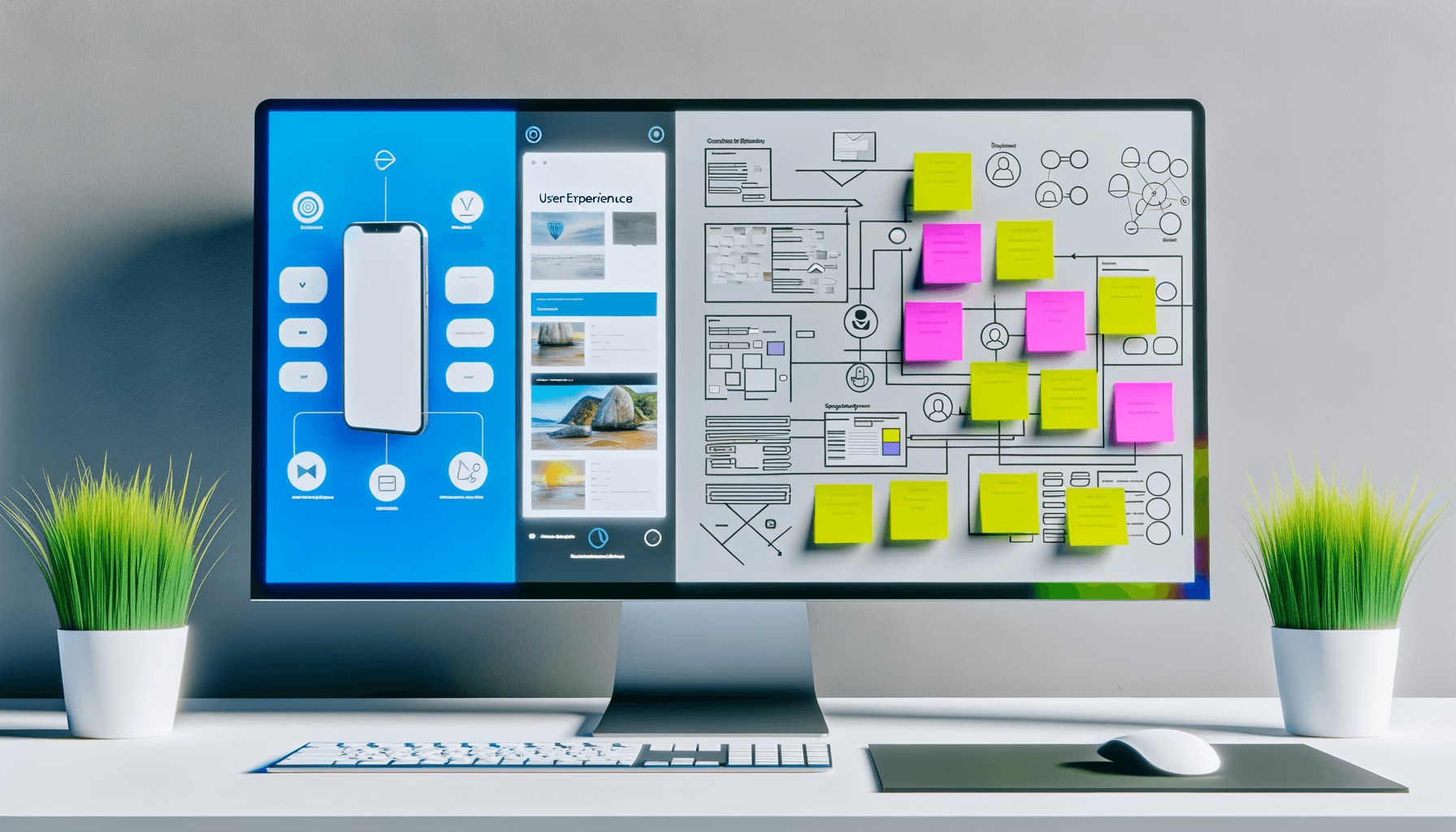
In the digital age, where websites and applications are integral to our daily lives, understanding the concepts of User Experience (UX) and User Interface (UI) is crucial. These terms are often used interchangeably, but they encapsulate different elements of the digital design process. This comprehensive guide will delve into the nuances of User Experience vs User Interface, helping you grasp the key differences and the significance of each in creating successful digital products.
Introduction
As businesses strive to provide seamless digital experiences, the roles of UX and UI design have become more prominent. Whether you’re a business owner, a designer, or someone just curious about digital design, understanding the distinction between User Experience vs User Interface is essential. But what do these terms really mean? How do they differ, and why are they both critical to developing engaging and effective digital products? This blog aims to unravel these questions, providing a clear, detailed exploration of UX and UI.
Understanding User Experience (UX)
What is User Experience?
User Experience (UX) refers to the overall experience a user has when interacting with a product or service. It encompasses all aspects of the end-user’s interaction with the company, its services, and its products. The goal of UX design is to create easy, efficient, relevant, and all-around pleasant experiences for the user.
The Elements of User Experience
- Usability: This is about how effectively users can achieve their goals when using the product. A usable product is intuitive, easy to learn, and efficient to use.
- Accessibility: Ensuring that a product is accessible means that people with disabilities can use it as efficiently as those without. This involves considering various needs and preferences.
- Desirability: A product should evoke positive emotions and satisfaction. This is where the product’s design, identity, and branding come into play.
- Value: The product should deliver value to the user, fulfilling their needs and expectations.
- Findability: Users should be able to easily find what they need within the product.
The Role of a UX Designer
UX designers are responsible for the research, design, and testing of the user experience. Their tasks include conducting user research, creating user personas, designing wireframes and prototypes, and performing usability testing. Their primary goal is to bridge the gap between the user’s needs and the business’s objectives.
The Importance of UX Design
Good UX design is fundamental in ensuring user satisfaction and loyalty. When users have a positive experience, they are more likely to continue using the product, recommend it to others, and show higher engagement levels. Effective UX design can significantly affect a company’s bottom line by reducing costs related to customer service and increasing customer retention.
Understanding User Interface (UI)
What is User Interface?
User Interface (UI) design is the process of making interfaces in software or computerized devices with a focus on looks or style. UI designers aim to create interfaces that users find easy to use and pleasurable. It encompasses everything the user interacts with—the buttons, icons, spacing, typography, color schemes, and responsive design.
The Elements of User Interface
- Visual Design: This includes the use of color schemes, typography, and layout to create an aesthetically pleasing and functional interface.
- Interaction Design: This focuses on creating engaging interfaces with well-thought-out behaviors. How does a button change when hovered over? How does a transition work when a page is loaded?
- Information Architecture: This involves organizing, structuring, and labeling content in an effective and sustainable way to help users find information and complete tasks.
- Prototyping: This is the process of building a model of the user interface to test its functionality and gather user feedback.
The Role of a UI Designer
UI designers are responsible for the look and feel of a product. They work closely with UX designers to ensure that the interface is visually appealing and aligned with the overall user experience. Their tasks include creating design systems, refining the layout, and ensuring the interface is responsive and interactive.
The Importance of UI Design
UI design is crucial as it directly impacts the user’s perception of the product. A well-designed interface can enhance usability and improve the overall user experience. It helps in building trust and credibility, which is essential for maintaining a competitive edge in the market.
User Experience vs User Interface: Key Differences
Focus and Goals
- User Experience: UX is concerned with the overall feel of the experience. It focuses on the user’s journey to solve a problem or complete a task. UX aims to provide a solution that meets user needs effectively.
- User Interface: UI is about the product’s look and function. It focuses on the visual elements and how users interact with them. UI design aims to create a compelling, aesthetically pleasing interface.
Interaction with Users
- User Experience: UX design involves understanding user behaviors, needs, and motivations through various research methods. It emphasizes user satisfaction and usability testing.
- User Interface: UI design involves creating the product’s layout and ensuring the aesthetic coherence of the visual elements. It focuses on the touchpoints where users interact with the product.
End Products
- User Experience: The end product of UX design is a wireframe or prototype that outlines the user journey and interaction flow. It’s a blueprint for creating an intuitive, efficient user experience.
- User Interface: The end product of UI design is the actual visual design of the product, complete with color schemes, typography, and responsive interactions.
Tools and Techniques
- User Experience: UX designers use tools like Sketch, Adobe XD, Figma, and Balsamiq for wireframing and prototyping. They employ techniques such as user testing, A/B testing, and analytics to refine the experience.
- User Interface: UI designers use tools like Adobe Photoshop, Illustrator, Figma, and Sketch for visual design. They focus on creating style guides, high-fidelity mockups, and interactive prototypes.
Collaboration and Overlap
While UX and UI are distinct fields, they often overlap and require collaboration. A successful digital product needs both excellent UX and UI design. UX provides the underlying structure, and UI brings it to life with visual and interactive elements. Collaboration between UX and UI designers ensures that the final product is not only functional but also visually engaging and user-friendly.
The Interplay Between User Experience and User Interface
The Synergy of UX and UI
A successful digital product harmoniously integrates both UX and UI design. While UX provides the foundation by understanding user needs and creating a blueprint for the product, UI adds the visual and interactive elements that make the product engaging and easy to use.
For example, consider a smartphone app. The UX design defines the user’s journey, ensuring that the app is easy to navigate, while the UI design ensures that the app is visually appealing and intuitively interactive. Together, they create a seamless experience that keeps users engaged and satisfied.
Case Studies: Real-World Applications
- Airbnb: Airbnb is a prime example of the seamless integration of UX and UI. The platform offers a user-friendly interface and an intuitive user journey, from booking a stay to discovering new experiences. The UX team focuses on understanding user needs and behaviors, ensuring that the platform is easy to use and provides value. Simultaneously, the UI team ensures that the interface is visually appealing and aligns with Airbnb’s brand identity.
- Spotify: Spotify has successfully combined UX and UI to create a music streaming service that’s both enjoyable and efficient. The UX design focuses on creating a smooth user journey, allowing users to easily discover and play music. The UI design complements this by providing a visually engaging experience with a sleek interface and interactive elements.
Common Misconceptions
Despite the clear distinctions between UX and UI, misconceptions abound:
- Misconception 1: UX and UI are the same: As we’ve explored, UX and UI are distinct disciplines, each with its own focus and goals.
- Misconception 2: UI is more important than UX: Both UX and UI are crucial for the success of a digital product. While a beautiful interface is important, it’s the user experience that determines how effectively a product meets user needs.
- Misconception 3: UX is only about usability: While usability is a key component of UX, it also encompasses other elements like accessibility, desirability, and overall satisfaction.
How to Choose Between Pursuing a Career in UX or UI
Skills and Qualities Required for UX Designers
- Empathy: Understanding user needs and behaviors is crucial.
- Problem-Solving: Ability to identify user problems and design effective solutions.
- Research Skills: Conducting user research and testing to gather insights.
- Communication: Clearly articulating design ideas and user needs.
Skills and Qualities Required for UI Designers
- Creativity: Designing visually appealing interfaces.
- Attention to Detail: Ensuring precision in the visual elements.
- Technical Skills: Proficiency in design tools and software.
- Understanding of Design Principles: Knowledge of typography, color theory, and layout.
Making the Decision
Choosing between a career in UX or UI depends on your interests and skills. If you enjoy understanding user behavior and designing solutions that address user needs, a career in UX might be for you. On the other hand, if you are passionate about visual design and creating stunning interfaces, UI design could be the right path.
Conclusion
In the ever-evolving digital landscape, the interplay between User Experience vs User Interface is vital for creating successful digital products. While UX focuses on the overall experience and solving user problems, UI emphasizes the visual and interactive aspects of the product. Both are essential, and their seamless integration leads to products that are not only functional but also enjoyable to use.
Understanding the differences between UX and UI and how they complement each other is crucial for anyone involved in digital design. Whether you’re a designer, developer, or business owner, recognizing the unique contributions of UX and UI can help you create more effective and engaging digital experiences.
As digital products continue to shape our world, the demand for skilled UX and UI designers will only grow. Whether you choose to specialize in one or embrace the synergy of both, a career in digital design offers exciting opportunities to innovate and enhance the way users interact with technology.



